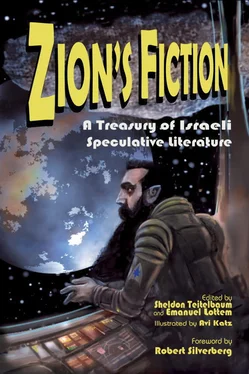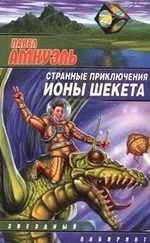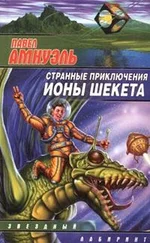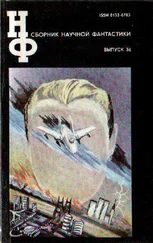In 2010 the acclaimed Israeli poet and novelist Shimon Adaf published a novel, Kfor (Frost), set in a far-future Tel Aviv in which a group of yeshiva students portentously begin to grow wings. Author and editor Nick Gevers applauded the novel’s “vivid description of life in Israel as well as… its subtle, incisive treatment of the fantastic as a phenomenon and as a literary genre.” Adaf is represented in the present volume with the story “They Had to Move,” selected from the commemorative thirtieth anniversary issue of Fantasia 2000 .
Perhaps the most sustained exploration of the nexus between Israel and the apocalyptic, however, can be found in Gail Hareven’s accomplished SF/F collection HaDerech leGan Eden (The road to heaven), published by Keter in 1999. In “Lir’ot et ha’Nolad” (literally, “to behold the newborn,” a Hebrew expression used to describe foresight), for example, a far-future society cognizant of impending end-times projects youngsters approaching their majority to near the end of human existence, where, it is hoped, they will witness glimmers of the causes of disaster and survive long enough to return home with useful intelligence. Gail Hareven is the most accomplished, and one of the few unabashedly genre savvy, of those mainstream Israeli authors to have discovered the promised land of SF/F.
Israeli theater has proved particularly amenable to representations of apocalypse. Literary scholar Zahava Caspi argues that this is because the stage is adept at showing the symptoms of the profound existential traumas that Israeli society has suffered since the Yom Kippur War of 1973. [48] Zahava Caspi, “Trauma, Apocalypse, and Ethics in Israeli Theatre,” CLCWeb: Comparative Literature and Culture 14, no. 1 (2012): 3.
The sense of redemption that emerged from the 1967 Six-Day War, and the sense of despair that followed the Yom Kippur War so soon afterwards, created an opening for messianic attitudes, in particular. Overall, theatrical representations of the apocalypse, especially during the 1970s, offered an outlet for what some might construe as a prodigious case of societal PTSD.
Caspi identifies two waves of apocalyptic theater in Israel, one corresponding to the Yom Kippur War near-defeat and the other to the Lebanon War and the First Intifada during the 1980s. Notable examples included Shmuel Hasfari’s 1982 play Tashmad (the Hebrew date corresponding to 1984), about a plan by Israeli settlers to destroy the Al Aqsa Mosque and replace it with a new temple; Motti Lerner’s Hevlei Mashiah (Premessianic tribulations), in which such a plan comes to fruition, sparking a regional war; Yehoshua Sobol’s 1988 Syndrome Yerushalayim (Jerusalem syndrome), which portrays Jerusalem’s destruction in AD 70 as an analogy to the situation in the occupied territories today; Hanoch Levin’s Retzah (1997; translated as Murder: A Play in Three Acts and an Epilogue , 2005), which depicts an endless procession of violent actions and reactions in the Middle East; Shimon Bouzaglo’s 2002 production of Geshem Shahor (Black rain), which ends with Israel under atomic attack; and Tamir Greenberg’s Hebron (2007), in which the earth denies burial to children killed in the conflict, spewing forth their bodies in a gallery of flames that engulfs the town of Hebron.
Nava Semel’s And The Rat Laughed , [49] Nava Semel, And the Rat Laughed [ Tzhok Shel Achbarosh ] (Proza, 2001; English translation, Melbourne, Australia: Port Campbell Press, 2008).
which deals directly with questions of the Holocaust and specific memories of that event, was afforded an operatic adaptation by the Tel Aviv Cameri Theatre with the Israel Chamber Orchestra, staged in April 2005. The narrative transpires after a “Great Ecological Disaster” inaugurates a cybernetic society in the micro-nation of TheIsrael at the onset of the twenty-second century.
Israeli author Savyon Liebrecht, also well known for her preoccupation with the Holocaust, creates an equally harrowing scenario in her novella A Good Place for the Night , which we include herein. Adam Rovner classifies the story as “futuristic Holocaust fiction.” If these stories present a variety of Israeli necropolises, Etgar Keret’s Tel Aviv, insofar as it figures in his 1998 novella HaKaytana shel Kneller ( Kneller’s Happy Campers ), is Limbo. A multivalent variation on Keret’s theme can be found in Ofir Touché Gafla’s 2003 Geffen Prize–winning tour de force Olam Basof ( The World of the End ). In it, a ghostwriter who cannot abide the death of his wife follows her into the afterlife. Michael Weingard of the Jewish Review of Books describes the book as “ Orpheus and Eurydice meets Alice in Wonderland .” [50] Savyon Liebrecht, A Good Place for the Night [ Makom Tov La’Laila ] (New York, Persea Books, 2006); Rovner, In the Shadow of Zion , 215; Etgar Keret, HaKaytana shel Kneller [ Kneller’s Happy Campers ], from the collection Ga’agu’ay leKissinger [ Missing Kissinger ] (London: Chatto & Windus, 2007) and adapted for film in 2006 as WristCutters: A Love Story and as the graphic novel Pizzeria Kamikaze in 2005; O. T. Gafla, Olam Basof [ The World at the End ] (2003; translated in English, New York: Tor, 2013).
Another recurring theme in Israeli speculative literature, alluded to above, is that of the alternate (or counterfactual) history. Literature itself is inevitably counterfactual by nature. As Rovner observes, “It represents possible worlds rather than a description of real states of affairs. Literature’s figurative language employs the creative potential latent in everyday language in order to open a horizon of new possibilities…. Gifted men and women marshal the incantatory power of words to vitalize the imaginary and render phantasms substantial.” [51] Rovner, In the Shadow of Zion , 215.
The Arab-Israeli conflict as actually played out was never really foreordained. “No sequence of events ever is. Matters could always have turned out otherwise…. Inevitability is a chimera, a product of organizing contingencies into a narrative that elides the haphazardness of existence.”
A number of allohistorical accounts have been published in Hebrew. Fans of Pulitzer Prize–winning American writer Michael Chabon, the author of The Yiddish Policeman’s Union , winner of the 2008 Hugo and Nebula Awards, may be surprised to learn that Israeli novelist and playwright Nava Semel covered similar, though certainly not identical, ground four years earlier in her own novel, Isra-Isle . In Chabon’s opus the remnants of a defeated Israel settle temporarily in a small autonomous region of Sitka, Alaska, in 1941, where they live in various degrees of disharmony with the local Inuit and Native American populations. In Semel’s novel, they live in upstate New York on an island settled by Native Americans. Both narratives, not incidentally, rely heavily on the conventions of detective fiction, SF, and alternate history.
Following on Semel’s consideration of a Territorialist solution to the Jewish problem, Yoav Avni considers the fortunes of a Jewish state based on the so-called Ugandist solution tabled by the British colonial secretary Joseph Chamberlain in 1903. The story, its original title Herzl Amar (“Herzl said,” the Hebrew equivalent of “Simon said”), transpires in a Jewish republic in East Africa whose problems in 2005 seem quite au courant with those of present-day Israel. For example, the Jewish state is planning a withdrawal from Maasai tribal territories while dismantling two of the country’s oldest Jewish settlements, threatening a civil war. The book’s protagonists, meanwhile, are completing their tours of duty in the IDF, intent upon backpacking to the Middle East, and specifically to the eternally moribund Holy Land, a magnet for post-compulsory-service pilgrims and transients.
Читать дальше






